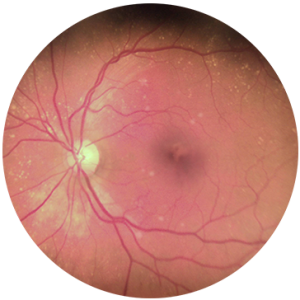
Macular degeneration
It is the third leading cause of blindness worldwide, after cataract and glaucoma
Así ve un paciente con degeneración macular avanzada
Drag the central bar to compare before and after


Before
After
- Es una enfermedad que afecta la mácula, zona de la retina responsable de la visión más detallada.
- Hay dos tipos de DMRE (degeneración macular asociada a la edad): seca y húmeda, siendo la segunda la más grave.
- En sus etapas tempranas no presenta síntomas y las personas suelen ver bien, con el examen de retinia se puede detectar a tiempo para prevenir que avance.
- Si no es tratada en etapas iniciales, la DMRE seca puede complicarse y presentar hemorragias, progresando a DMRE húmeda.
- Afecta al 30% de los adultos mayores de 70 años, es recomendable que a partir de los 40 años comiencen con revisiones regulares de retina que dañan aún más la retina.

Treatment
The progression of dry AMD is controlled with:
- Dieta rica en omega 3 y antioxidantes.
- Hacer eiercicio.
- Dejar de fumar.
- Protegerse del sol con lentes oscuros.
Wet AMD requires controlling hemorrhages with:
- Inyecciones intraoculares antiangiogénicas.
- Terapia láser que cicatriza los vasos frágiles.

Risk factors
- Edad, sexo (más prevalente en mujeres), tabaquismo, malos hábitos alimenticios, hipertensión arterial, problemas circulatorios y obesidad.
Evolución en la imagen de fondo de ojo
- Ojo sano
- Leve
- Intermedia
- Avanzada




Cambios en la visión del paciente
- Ojo sano
- Leve
- Intermedia
- Avanzada




